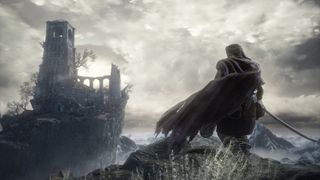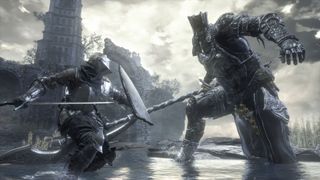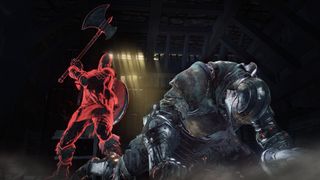GamesRadar+ Verdict
Dark Souls used to feel like a gigantic trap. Dark Souls 3, for better and for worse, feels like home. The third in the trilogy is bewitching while it lasts, but may not leave you wanting more.
Pros
- +
The stylistic mixture of Bloodborne and Dark Souls 1
- +
The organic
- +
entwined world layout
- +
The sly hints about the events of previous games
- +
The enhancements to melee combat
Cons
- -
The plunging frame-rate during bossfights
- -
The lack of real novelty
Why you can trust GamesRadar+
Dark Souls 3 hasn't so much learned from its predecessors as devoured them, ripping into their narratives and geographies as it searches for a way of standing apart, of starting afresh. Roving the realm of Lothric is like wading through an enormous intestine, swimming with gobbets of the original game's Lordran and Bloodborne's Yharnam - a familiar statue, a ring's item description that hints at a forgotten ancestry, a particular area-of-effect attack that had me shouting in recognition even as it tore my health bar in two.
At times this is a purebred Dark Souls sequel, a labyrinth of faded masonry populated with suspicious-looking gargoyles, where you'll wage ferocious yet dignified jousts against knights equipped with swords and spears. But then the skin splits and it's a Bloodborne sequel in all but name, offering up pyres of burning corpses and wiry, crimson-eyed abominations who'll knock you off-balance with raking combos or slide around your defences, reaching for your jugular. Sometimes you feel like a survivor, inching through deceptively beautiful chambers with shield held out like a letter of apology. And sometimes, you feel like a tiny but terrible predator, diving through the swipes of giants and dragons to strike at ankle and underbelly.
The two styles are expertly blended over the course of a majestic 60-70 hour adventure, and you can, of course, shift the emphasis by tweaking your character's stats appropriately. But one significant drawback is that Dark Souls 3 lacks a voice of its own. In broad terms it's a rewrite of the original: the player is once again a cursed undead, resurrected to seek redemption by slaughtering corrupted beings and exchanging their souls for level-ups and gear. Your quarry this time are four wayward Lords of Cinder, whose embers must be restored to their thrones in Lothric's version of Lordran's Firelink Shrine. As with Majula in Dark Souls 2, the latter now serves as a distinct customisation hub, accessible via teleportation from bonfire checkpoints out in the world, where you'll encounter merchants, a mournful Firekeeper who handles character levelling and Andre, the original game's grandfatherly blacksmith.
Talk of Dark Souls 2 may give seasoned Souls cartographers the shakes, but fear not. Dark Souls 3's geography isn't nearly as disconnected, though it can't rival the exquisitely meshed, wraparound terrain of the original. The game takes place in the grounds of a gigantic castle, spilling down from airy battlements to a village, forests, a cathedral, a diseased swamp and skeleton-ridden catacombs that take you beyond the curtain wall to a frostbitten citadel. Many of the key locations are visible from a distance, and, as with Lordran, contemplating an area you've just overcome from a precipice satisfies in a way no item reward ever could. All that toil and terror, all those agonising scraps with the dregs of series creator Hidetaki Miyazaki's subconscious, reduced to a huddle of turrets on the horizon.


One area of Dark Souls 3 that could do with patching, the performance issues aside, is magic. At the time of writing, characters who rely on sorcery and miracles seem weak next to melee characters. Pyromancy specialists have a better time of things, because the pyromancy flame at least doesn't weigh you down like a wizard's staff or a priest's charm, allowing you to wield it comfortably alongside a hefty greataxe. Bosses also skew towards speed and aggression in this game, so hanging back to throw spells is less of an option.
Certain sections are quite linear, but even the most claustrophobic is packed with secrets and shortcuts – an item dangling from a window you can't reach from inside a building, or elevators that save you the trouble of tussling with minions en-route to a boss. You can also trigger key encounters in different orders given a bit of calculation, perhaps unlocking alternative endings in the process, and there are entire regions, together with important NPC sidestories, that you'll miss if you fail to heed the clues squirrelled away in the dialogue and lore.
Lothric's splendour is, alas, hampered by a few too many callbacks to locations from previous games, though the idea is often as much to desecrate as celebrate. More problematically, the game's single act narrative arc robs the world of thematic weight. There isn't that renewed sense of purpose you may have felt on obtaining the Lordvessel in Dark Souls 1, or downing Rom in Bloodborne. Bosses, meanwhile, run the gamut from the surgical through the grandiose to the slightly gimmicky. There are entities you'll best by dint of meticulous pattern-reading and a sixth sense for the difference between a combo finisher and a linking attack – gruelling encounters that represent videogame combat at its most sophisticated. But there are also big bads that are more about spectacle, where victory is a question of poking a vulnerable bit till it pops, or exploiting something in the environment, though it may repay you to fight without resorting to such measures.

It's a tremendous rogue's gallery for the most part, with each enemy a grotesque expression of some cosmic failing or tragedy, but I'm not sure there's a star - veterans hoping for a clash as smart and punishing as Ornstein and Smough may leave disappointed. My standouts include the Dancer of the Boreal Valley, a crooked yet balletic titan whose fluid animations are difficult to time, and Aldrich, Saint of the Deep, a grisly sorcerer with a very, shall we say, close relationship to Lords of yore.
The combat system itself remains substantial and punchy, despite a frame rate that sinks well below 30 during more SFX-heavy battles. It's built once again around blocking, rolling, backstabs, parrying and two-handing weapons for extra damage, but there are now Weapon skills – florid category-specific specials such as charging spear strikes and guard-breaking uppercuts that devastate when they connect, but generally leave you wide open when they don't. These draw on a new Focus Point gauge that's also drained by magic (spells no longer have a set number of uses), and is refilled by drinking new “Ash” Estus flasks that share inventory space with the basic health-replenishing variety. Naturally, tethering magic and weapon arts to the same resource pool obliges you to be clear about which style you favour. Are you the kind to lob lightning bolts and poison clouds, or would you rather raise the might of your axe-swing care of the War Cry skill?
The skills system seems more skin-graft than sea-change, in hindsight – I polished off most AI opponents using the older tactic of riling them from afar with fireballs, then somersaulting in and out of swiping range. But the true test of its worth will be how it holds up in PvP over the months to come. As in previous games, forging “covenants” with certain elusive NPCs opens the way to particular flavours of multiplayer. Disciples of the sunlight covenant are pillars of the community, placing their summon sigils to aid those struggling with bosses or nefarious red phantoms. The latter, meanwhile, are Lothric's highwaymen, invading worlds to murder their hosts.

In place of the original multiplayer Humanity system, Dark Souls 3 gives you Embers that can be crushed in return for a health bar extension and the ability to summon co-op partners, at the price of opening the door to a possible invasion. It's a simplification that may annoy returning players, but it does make crossing the barrier between solo and fully online play much more tempting, which should result in a livelier PvP community. From has also streamlined equipment upgrades - you can no longer reinforce armour and clothing, which scales up with your character's level. There are still plenty of armour sets to collect and play around with, however - some built to last, others for agility - and the overhauled weapon customisation is robust enough to pick up the slack. In addition to raising the base strength using titanite, you'll discover gems that apply status effects or scale a weapon's power based on individual stats.
It's a persuasive reshuffle of the feature set, on the whole, reinforcing the original's machinery while throwing in a few new wrinkles for veterans. But it's expressive of a game that's more about putting a capstone on a formula than raising the roof. Dark Souls 3 is a vigorous tale of sacrifice and cunning. It is oblique, punishing and gratifying in a way mainstream console blockbusters seldom dare to be. But the fires are definitely dying. There's been some uncertainty over whether this is the final Dark Souls title – Miyazaki has suggested as much, but the endings contain dutiful hints about future sequels. As much as I love Dark Souls, and as much as I've enjoyed this one, I think it's time to say goodbye.
More info
| Genre | Role Playing |
| Description | The third and final instalment in the Dark Souls series. Not the last 'Souls' title from From Software, but the dark conclusion to the trilogy. |
| Platform | "Xbox One","PC","PS4" |
| Alternative names | "Dark Souls III" |
| Release date | 1 January 1970 (US), 1 January 1970 (UK) |

